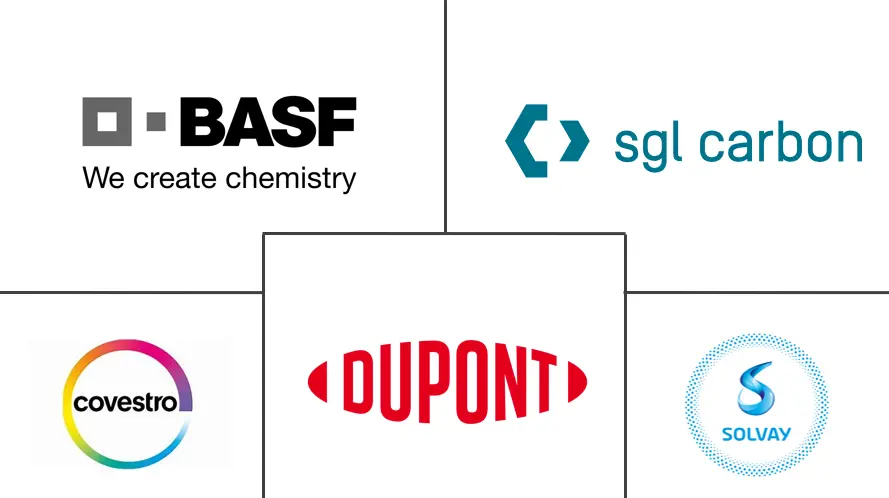Automotive Polymer Composites Market Size and Share
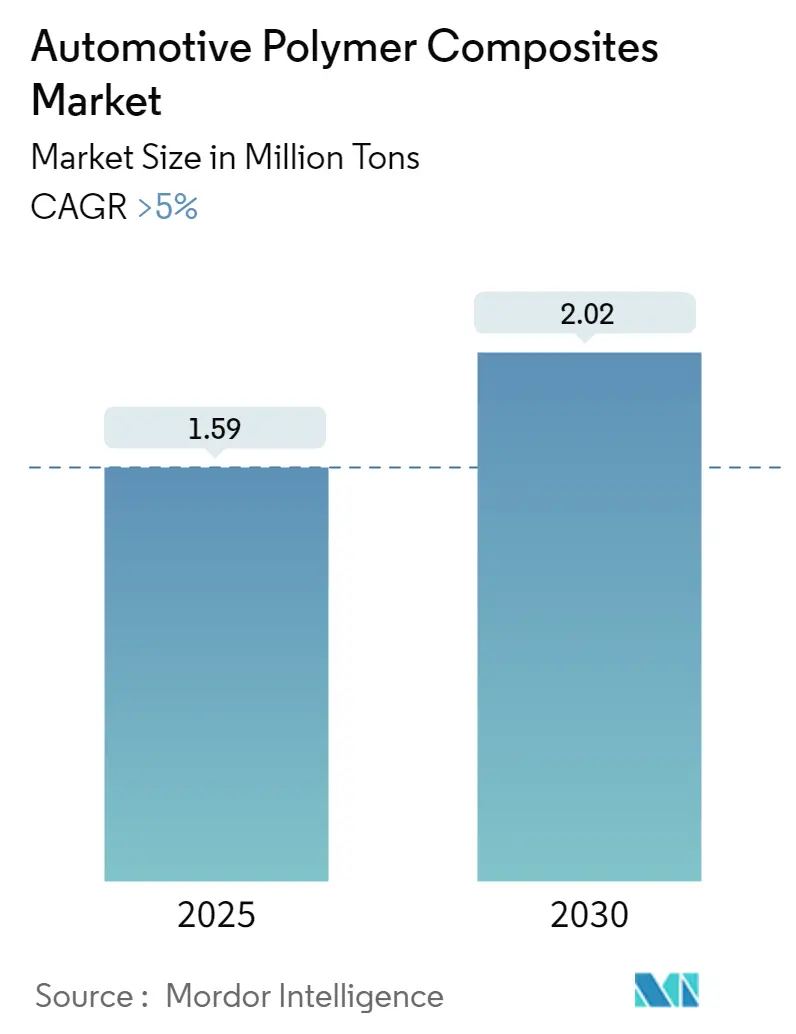
Automotive Polymer Composites Market Analysis by Mordor Intelligence
The Automotive Polymer Composites Market size is estimated at 1.59 million tons in 2025, and is expected to reach 2.02 million tons by 2030, at a CAGR of greater than 5% during the forecast period (2025-2030).
The COVID-19 pandemic significantly impacted the automotive polymer composites market by disrupting the supply chain, causing production to slow down and shut down and an economic downturn. By overcoming the remaining challenges and capitalizing on the market trends, the automotive polymer composites market is poised for a positive future, revolutionizing the automotive industry with its lightweight, high-performance materials.
Lighter vehicles are more fuel-efficient and emit less pollution, which is driving demand for automotive polymer composites in the global market, which are lighter than traditional materials such as steel and aluminum.
On the flip side, compared to traditional materials like steel and aluminum, the processing and manufacturing of polymer composites often involve complex and labor-intensive techniques, driving up costs and is expected to act as a restraint for the automotive polymer composites market.
Innovations in robotics, automation, and digitalization are streamlining composite production processes, reducing costs and lead times, and creating exciting possibilities for the global market.
Asia-Pacific is estimated to dominate the market, with the most significant consumption coming from countries like China, India, Japan, and South Korea.
Global Automotive Polymer Composites Market Trends and Insights
Increasing Use of Polymers in the Light Vehicle Segment
- The automotive industry is undergoing a significant transformation, with lightweight emerging as a critical driver for fuel efficiency and performance improvements. In this shift, polymers are playing a starring role, increasingly replacing traditional materials like steel and aluminum in light vehicles.
- The automotive industry has been focusing on vehicle weight reduction for decades, as vehicle weight has a direct impact on driving dynamics and fuel efficiency. As per the US Department of Energy (DOE), reducing the weight of vehicles by 10% yields an increase of 6-8% in fuel economy. As governments around the world implement stringent emission regulations and plan to set even higher emissions standards in the coming years, the importance of lightweight materials is expected to increase.
- Major composite polymers used in automobiles are based on polypropylene, polyurethanes, nylon, polyvinyl chloride, acrylonitrile-butadiene-styrene (ABS), and others. Polypropylene and polyurethanes only account for more than 40% of the market studied.
- Automakers also use prepregs(a type of polymer composite) to replace metals in interior and exterior parts, reducing weight for better performance and safety. Modernization and autonomous vehicle development drive demand.
- Carbon prepregs are versatile and can be molded into various densities, shapes, and sizes, making them a popular substitute for aluminum and steel in the aviation and automotive industries. Major automakers like BMW, Ferrari, and Lexus are actively designing new models with complete carbon fiber body structures. For example, the second-generation BMW M2, launched in May 2023, is made mainly of carbon fiber, including the roof, interior, and vehicle components.
- Racing car manufacturers reduce curb weight to improve fuel efficiency and speed. According to a US Department of Energy report, a 10% reduction in vehicle weight can improve fuel economy by 6-8%. This makes prepregs highly sought-after in the automotive and transportation industries, especially for racing and high-speed vehicles.
- According to the International Organization of Motor Vehicle Manufacturers (OICA), the global automotive industry grew by 6% in 2022 compared to 2021. Automotive production increased in developed and developing countries worldwide, including China, Germany, South Korea, Canada, the United Kingdom, and Italy. Over 85 million motor vehicles were manufactured in 2022.
- According to OICA, light commercial vehicle production across the world increased in 2022 compared to 2021 by 7%, with 19.86 million units produced in 2022. The majority of the production comes from American regions, with about 60% of the total light commercial vehicles produced across the world.
- Moreover, according to the Society of Motor Manufacturers and Traders, British commercial vehicle production grew by 39.3% (as compared to 2021) to 101,600 units in 2022. The output for the domestic market in 2022 rose by 14.0 percent year-on-year to 40,409 units, with 101,600 vans, trucks, taxis, buses, and coaches leaving factory lines. The increased automotive manufacturing activities would aid the growth of the studied market during the forecast period.
- Hence, an increasing share of plastics in automobiles is expected to boost the automobile polymer composites market.
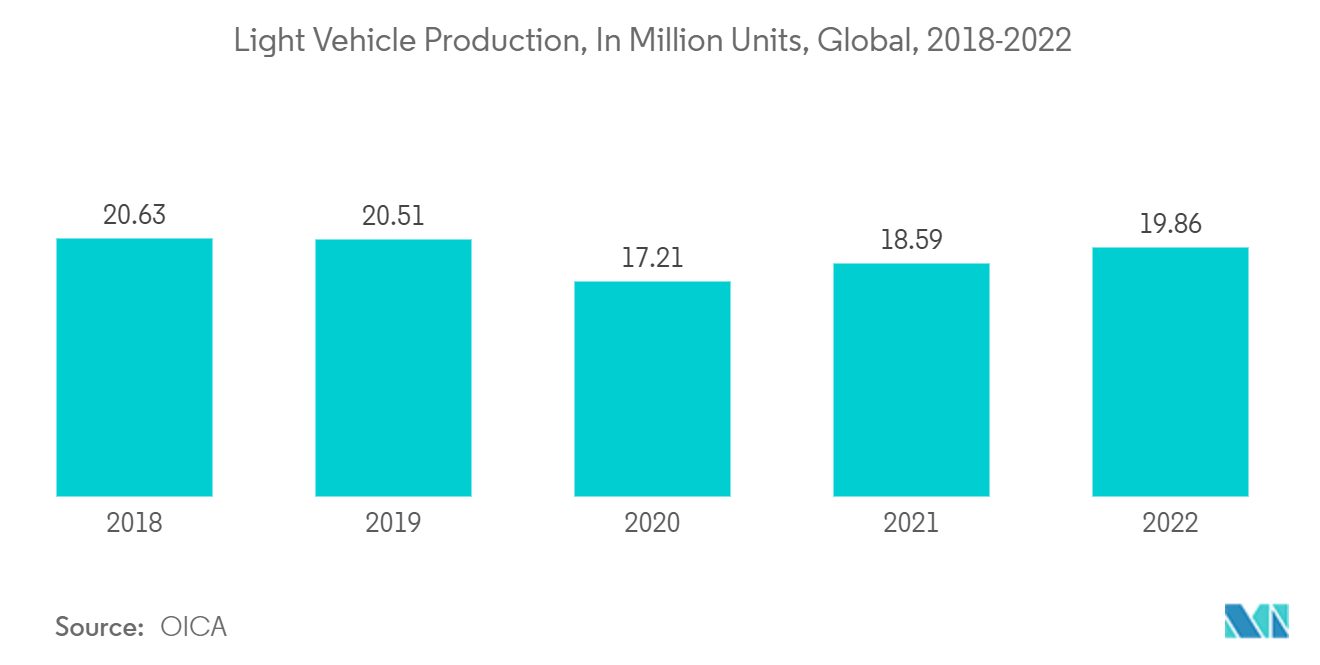
Asia-Pacific is Expected to Dominate the Market
- The Asia-Pacific region is expected to dominate the automotive polymer composites market throughout the forecast period, with its large market share driven by increasing demand from heavy consumption from countries like China, India, South Korea, and more.
- According to the OICA, motor vehicle production in the Asia-Pacific region grew by 7% in 2022 compared to 2021. Developed and developing countries in the area, such as China, South Korea, and India, experienced an upsurge in automotive production in 2022. Over 50 million motor vehicles were manufactured in the Asia-Pacific region in 2022.
- Furthermore, in the first nine months of 2022, Indian passenger car sales remained strong due to savings, lower interest rates, and an increasing preference for personal mobility, which convinced customers to buy new cars. As a result, new car registrations in India grew by around 20.2% in the first three quarters of 2022 to reach 2.8 million units. Also, government reforms such as "Aatma Nirbhar Bharat" and "Make in India" programs supported the country's automotive industry.
- Under the new scrappage policy, governments in Asia-Pacific countries, like India, South Korea, and China, seek to push heavy-duty truck owners to acquire new heavy-duty trucks and other commercial vehicles, discouraging the use of old, polluting ones. The program would reduce pollution levels and promote the advancements of the heavy trucks segment in adopting polymer composites.
- Moreover, the Chinese government estimates a 20% penetration rate of electric vehicle production by 2025. This is reflected in the country's electric vehicle sales trend, which went to a record-breaking high in 2022. As per the China Passenger Car Association, the country sold 5.67 million EVs and plug-ins in 2022, almost double the sales figures achieved in 2021. The market is anticipated to increase the demand for automotive polymer composites in the country, and sales are poised to continue at this moment.
- The factors above and supportive government regulations are contributing to the increased demand for automotive polymer composites in the region.
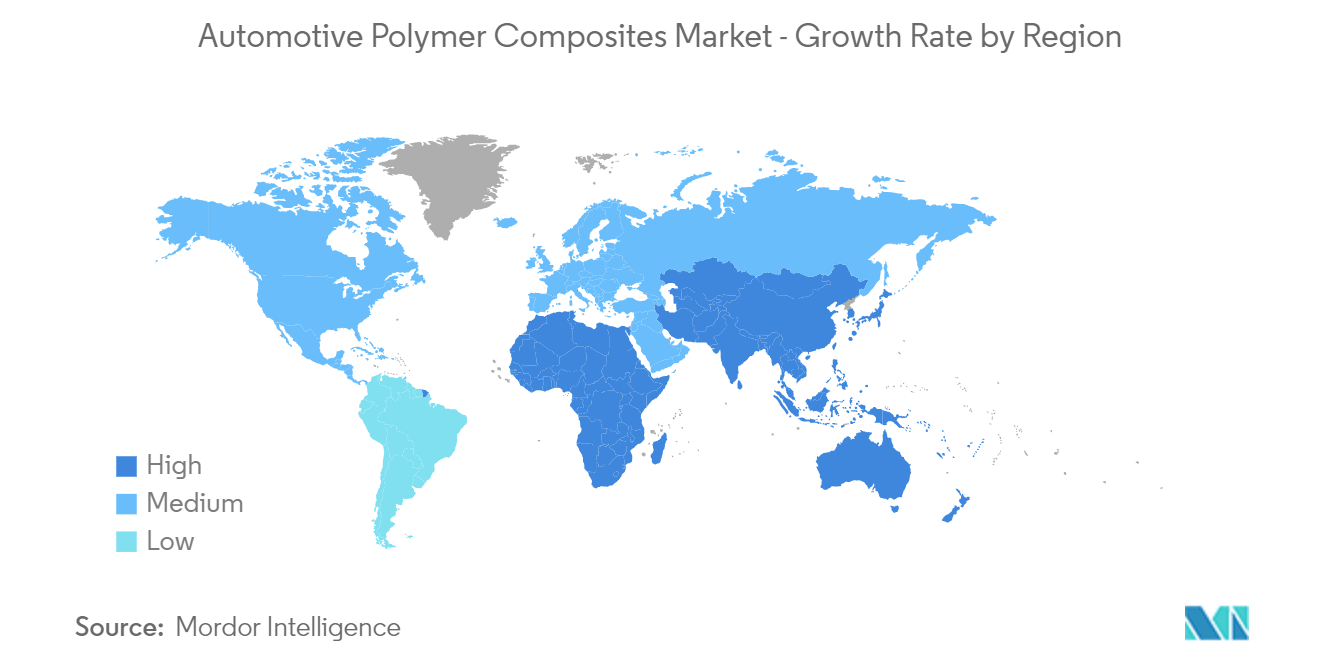
Competitive Landscape
The market studied is partially consolidated in nature. The major players (not in any particular order) include BASF SE, SGL Group, Covestro AG., Solvay, and DuPont.
Automotive Polymer Composites Industry Leaders
-
BASF SE
-
SGL Carbon
-
Covestro AG
-
DuPont
-
Solvay
- *Disclaimer: Major Players sorted in no particular order
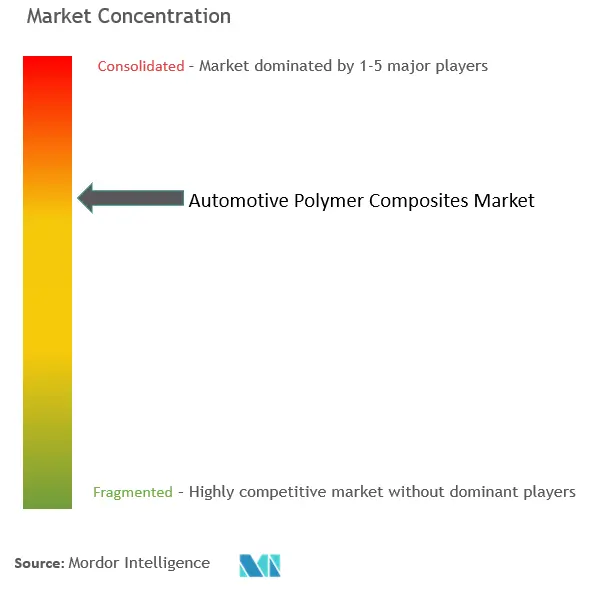
Recent Industry Developments
Feb 2023: Pyrophobic Systems Ltd, which is one of the leading thermoplastic and resin companies for battery and construction safety applications, announced that its product LithiumPrevent 200 material was selected for battery application by the OEM giant General Motors.
Apr 2022: Gurit Holdings AG announced the acquisition of a 60% share of Fiberline Composites AS, a manufacturer of pultruded carbon and glass fiber products used in wind blade production.
Global Automotive Polymer Composites Market Report Scope
Automotive polymer composites are materials made by combining polymers (plastics) with reinforcing fibers, such as glass, carbon, or aramid. This creates a material that is stronger, lighter, and more durable than the polymer itself.
The Report Covers Automotive polymer composites Market Analysis and is segmented by Resin (Polypropylene, Polyurethanes, Nylon, Polyvinyl Chloride, ABS, Polyethylenes, Polycarbonate, and Other Resins), Vehicle Type (Passenger Cars, Light Commercial Vehicles, and Trucks and Buses), and Geography (Asia-Pacific, North America, Europe, South America, and Middle-East and Africa). For each segment, the market sizing and forecasts were made on the basis of volume (tons).
| Polypropylene |
| Polyurethanes |
| Nylon |
| Polyvinyl Chloride |
| ABS |
| Polyethylenes |
| Polycarbonate |
| Others Resins Type (Polyetheretherketone, Polyester, etc.) |
| Passenger Cars |
| Light Commercial Vehicles |
| Trucks and Buses |
| Other Vehicle Types (Sports Cars, Specialty Vehicles, etc.) |
| Asia-Pacific | China |
| India | |
| Japan | |
| South Korea | |
| Malaysia | |
| Thailand | |
| Indonesia | |
| Vietnam | |
| Rest of Asia-Pacific | |
| North America | United States |
| Canada | |
| Mexico | |
| Europe | United Kingdom |
| France | |
| Germany | |
| Italy | |
| Spain | |
| NORDIC Countries | |
| Turkey | |
| Russia | |
| Rest of Europe | |
| South America | Brazil |
| Argentina | |
| Colombia | |
| Rest of South America | |
| Middle-East and Africa | Morocco |
| South Africa | |
| Nigeria | |
| Qatar | |
| Egypt | |
| UAE | |
| Rest of Middle-East and Africa |
| Resin Type | Polypropylene | |
| Polyurethanes | ||
| Nylon | ||
| Polyvinyl Chloride | ||
| ABS | ||
| Polyethylenes | ||
| Polycarbonate | ||
| Others Resins Type (Polyetheretherketone, Polyester, etc.) | ||
| Vehicle Type | Passenger Cars | |
| Light Commercial Vehicles | ||
| Trucks and Buses | ||
| Other Vehicle Types (Sports Cars, Specialty Vehicles, etc.) | ||
| Geography | Asia-Pacific | China |
| India | ||
| Japan | ||
| South Korea | ||
| Malaysia | ||
| Thailand | ||
| Indonesia | ||
| Vietnam | ||
| Rest of Asia-Pacific | ||
| North America | United States | |
| Canada | ||
| Mexico | ||
| Europe | United Kingdom | |
| France | ||
| Germany | ||
| Italy | ||
| Spain | ||
| NORDIC Countries | ||
| Turkey | ||
| Russia | ||
| Rest of Europe | ||
| South America | Brazil | |
| Argentina | ||
| Colombia | ||
| Rest of South America | ||
| Middle-East and Africa | Morocco | |
| South Africa | ||
| Nigeria | ||
| Qatar | ||
| Egypt | ||
| UAE | ||
| Rest of Middle-East and Africa | ||
Key Questions Answered in the Report
How big is the Automotive Polymer Composites Market?
The Automotive Polymer Composites Market size is expected to reach 1.59 million tons in 2025 and grow at a CAGR of greater than 5% to reach 2.02 million tons by 2030.
What is the current Automotive Polymer Composites Market size?
In 2025, the Automotive Polymer Composites Market size is expected to reach 1.59 million tons.
Who are the key players in Automotive Polymer Composites Market?
BASF SE, SGL Carbon, Covestro AG, DuPont and Solvay are the major companies operating in the Automotive Polymer Composites Market.
Which is the fastest growing region in Automotive Polymer Composites Market?
Asia Pacific is estimated to grow at the highest CAGR over the forecast period (2025-2030).
Which region has the biggest share in Automotive Polymer Composites Market?
In 2025, the Asia Pacific accounts for the largest market share in Automotive Polymer Composites Market.
What years does this Automotive Polymer Composites Market cover, and what was the market size in 2024?
In 2024, the Automotive Polymer Composites Market size was estimated at 1.51 million tons. The report covers the Automotive Polymer Composites Market historical market size for years: 2019, 2020, 2021, 2022, 2023 and 2024. The report also forecasts the Automotive Polymer Composites Market size for years: 2025, 2026, 2027, 2028, 2029 and 2030.
Page last updated on:
Automotive Polymer Composites Market Report
Statistics for the 2025 Automotive Polymer Composites market share, size and revenue growth rate, created by Mordor Intelligence™ Industry Reports. Automotive Polymer Composites analysis includes a market forecast outlook for 2025 to 2030 and historical overview. Get a sample of this industry analysis as a free report PDF download.
